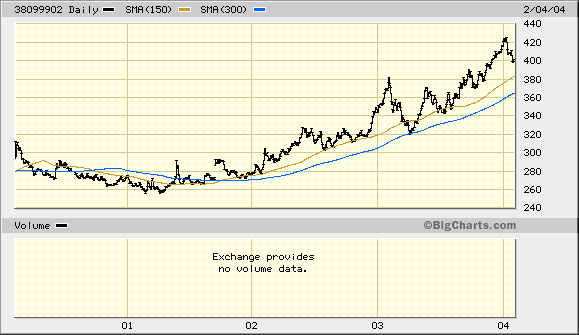A Moving Averages Overview of the Gold Market
After a 4-week correction, gold investors are asking where gold will find support before ultimately ending its corrective decline. Obviously, this is the question of the hour and using some of gold'sdominant moving averages I think we can ascertain with a fair amount of accuracy where that support is likely to occur.
What are the most dominant moving averages for gold? Two of the most dominant MAs are the 30-week and 60-week moving averages, since they are reflections of the 120-week Master Cycle first discovered by Samuel J. Kress. Moving averages are extremely important for not only isolating trends, momentum, and support/resistance, but more importantly, for highlighting the underlying bias of the dominant trading cycles. Basically, a properly selected moving average represents the half-cycle of whatever cycle you are following. Since gold is dominated mainly by the 30-week, 60-week and 120-week cycles, it only stands to reason that the 30-week, and 60-week simple moving averages are the best ones for gold. Sure enough, the charts confirm this as any back-test of these three moving averages will prove.
The moving averages reflect the dominant trend and bias of gold prices and therefore are a reflection of what all the "insiders" know about gold -- that is, the fundamental factors influencing gold price movements. In a sense, the key moving averages distill all the gold market fundamentals for the investor and thereby eliminate this tiresome chore. Leave the fundamental research to the Wall Street analysts and the insiders and let the moving averages "tell the tale"!
Let's begin with the present. Gold is currently just below the "psychologically important" $400 level but is slightly above its most recent low near $395. The fact that gold has held up under selling pressure all this week is in part due to the 7-month uptrend line which hasn't yet been broken. Gold is currently wrestling with this important short-term trend line at the $395 area and I believe we'll have resolution one way or the other by early next week. In other words, if gold is going to signal its intent to fall further it will do so by decisively penetrating the 7-month uptrend.
What if the recent low at the $395 area is broken in coming days? Then we'll turn our attention to the 30-week moving average which currently intersects the $380-$385 area. The 30-week moving average is rising at a good rate of change so it's likely to produce the first big bounce for gold if the $395 area fails. The 30-week moving average reversed all of gold's declines in 2002 and all but one decline in 2003.
Which moving average came to gold's rescue last year when the 30-week MA failed? Why, the 60-week MA of course! Note the successful test and reversal off the rising 60-week MA in early 2003 in the chart below. This very important moving average currently intersects at about $367.

Back to the 30-week MA. As previously mentioned this moving average intersects the $380-$385 area, along with many other important trend lines and pivot points. Assuming the 7-month uptrend at $395 is broken, what if the 30-week MA also fails to act as support? In that event it would represent a serious correction which would likely take a few months to recover from. In other words, it would mean a correction of intermediate-term proportions. But until the 7-month uptrend at $395 is broken the assumption is that the trend remains up.
February 6, 2004
Clif Droke is the editor of the Durban Deep/XAU Report, a daily forecast and analysis of DROOY, GLG, KGC, XAU, HUI, and GOX written especially for day traders. He is also the author of numerous books on finance and investing, including the top-selling "Moving Averages Simplified." Visit his web site for free samples of his analysis at www.clifdroke.com
















